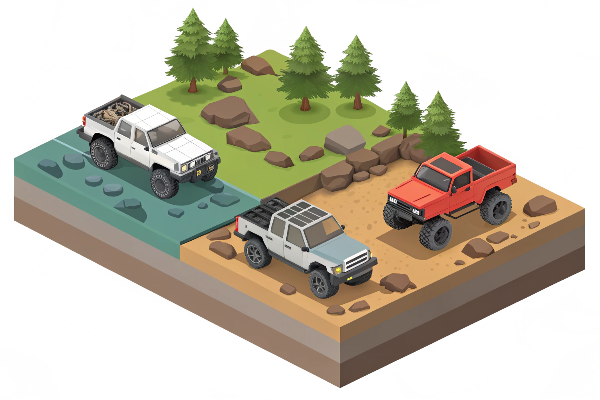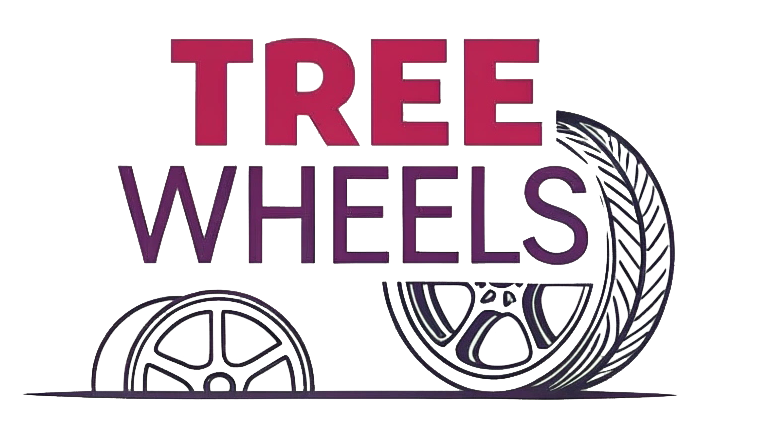You want that aggressive off-road look with bigger rims, but worry about performance and durability. Many truck owners face this dilemma when considering 20-inch wheels for off-road adventures.
Yes, you can off-road with 20-inch rims, but with limitations. Modern 20-inch wheels, especially forged ones, can handle light to moderate off-roading when paired with appropriate tires that maintain adequate sidewall height. However, they're less ideal than smaller 16-18 inch wheels for extreme terrain.
 on moderate off-road trail off-road truck with [20-inch wheels](https://www.reddit.com/r/overlanding/comments/kokcmk/are_20inch_wheels_good_for_offroading/)](https://treewheels.com/wp-content/uploads/2025/09/image-1-off-road-truck-with-20-inch-wheels-styl.png)
The growing popularity of larger diameter wheels has changed how we think about off-road setups. As a manufacturer of premium forged wheels, I've guided countless customers through this decision. Let's explore the reality of using 20-inch rims beyond the pavement and what factors truly matter for your off-road adventures.
Are 20-inch wheels ok for off-road?
You've seen impressive trucks with larger wheels tackling trails, but wonder if they're compromising performance for looks. This tension between style and capability creates real confusion for off-road enthusiasts.
20-inch wheels can be suitable for light to moderate off-roading, especially with quality forged construction and appropriate tires. The key is maintaining adequate overall tire diameter with enough sidewall to absorb impacts and provide traction, while choosing wheels engineered specifically for off-road durability.
 in off-road conditions comparison of different wheel sizes for off-roading](https://treewheels.com/wp-content/uploads/2025/09/image-2-comparison-of-different-wheel-sizes-for.png)
From my experience producing wheels for various terrain applications, the performance gap between traditional off-road sizes and 20-inch options has narrowed significantly. Modern manufacturing techniques allow us to create 20-inch forged wheels that are both stronger and lighter than older designs. The critical factor isn't just wheel diameter but the overall wheel-tire package.
When we design 20-inch wheels for customers who enjoy occasional off-roading, we focus on reinforcing the areas most vulnerable to impact damage. Our engineering team utilizes advanced flow-forming and forging techniques that distribute material more efficiently, creating wheels that can withstand reasonable off-road use despite their larger diameter.
However, I always remind customers that vehicle limitations significantly restrict what wheel sizes you can actually install. Not every vehicle can accommodate any wheel size you desire. Before making a choice, consult with professional wheel specialists or check automotive parts websites for compatibility information. We frequently guide customers through this process to ensure they select wheels that are both functionally appropriate and physically compatible with their specific vehicle model.
What are the disadvantages of 20-inch rims?
You're drawn to the commanding presence of 20-inch rims, but hesitate because of concerns about durability and performance. This conflict between aesthetics and practicality troubles many enthusiasts considering larger wheels.
The main disadvantages of 20-inch rims for off-roading include reduced tire sidewall protection, increased risk of wheel damage, potentially harsher ride quality, limited tire options for serious off-road use, and greater vulnerability to obstacles like rocks and ruts.

Throughout my years in the wheel manufacturing business, I've seen firsthand the tradeoffs customers make when choosing larger diameter wheels for off-road use. The physics are straightforward: with a 20-inch wheel, you have less tire sidewall to absorb impacts and protect the rim. This creates several cascading effects that off-road enthusiasts should consider.
First, the reduced sidewall means less cushioning over rough terrain, translating to a harsher ride quality. This not only affects comfort but can impact vehicle control in challenging conditions. Second, the larger diameter presents a bigger target for rocks, stumps, and other obstacles, increasing the likelihood of damage. Even our most durable forged wheels cannot completely overcome these physical realities.
Another consideration is weight. Despite advancements in manufacturing, 20-inch wheels typically weigh more than smaller options, affecting suspension performance and potentially increasing unsprung weight. This can negatively impact handling, particularly in situations requiring precise wheel control like rock crawling or technical trails.
Tire selection also becomes more limited with 20-inch wheels. While there are increasingly more options available, the most capable off-road tires are still predominantly designed for 16-18 inch wheels. The available 20-inch off-road tires often represent compromises in capability compared to their smaller counterparts.
| Wheel Size | Sidewall Protection | Ride Comfort Off-Road | Tire Options | Impact Resistance |
|---|---|---|---|---|
| 16-17 inch | Excellent | Excellent | Numerous | High |
| 18-19 inch | Good | Good | Many | Moderate |
| 20 inch | Fair | Fair | Limited | Lower |
| 22+ inch | Poor | Poor | Very Limited | Very Low |
What size rim is best for offroading?
You're planning serious off-road adventures and want wheels that won't let you down when the terrain gets tough. The multitude of options creates uncertainty about the optimal choice for your specific needs.
For dedicated off-roading, 16-18 inch wheels are typically best as they allow for taller tire sidewalls that provide better cushioning, traction, and protection. This size range offers the ideal balance of durability, performance, and tire selection for most off-road applications.

In my experience working with off-road enthusiasts from professional racers to weekend warriors, the consensus on optimal wheel size has remained relatively consistent despite changing trends. The 16-18 inch range continues to dominate serious off-road applications for several compelling reasons.
From a manufacturing perspective, smaller diameter wheels can be designed with greater structural integrity relative to their weight. When we forge 16-17 inch wheels for dedicated off-road use, we can create incredibly strong products without excessive weight. The physics of impact resistance also favor smaller diameters, as the wheel face presents a smaller target to potential obstacles.
Tire technology is another critical factor. The most advanced off-road tire compounds and tread patterns are developed primarily for 16-18 inch applications. These tires benefit from decades of refinement specifically for off-road performance. The taller sidewalls these wheels accommodate allow for better air-down performance—a crucial technique for increasing traction in sand, mud, and over rocks.
The benefits extend beyond just performance. Smaller wheels typically cost less than larger alternatives, and their tires are usually more affordable as well. This practical consideration becomes significant when you consider that off-road driving increases the likelihood of damage, potentially requiring replacement.
| Off-Road Activity | Ideal Wheel Size | Key Benefit |
|---|---|---|
| Rock Crawling | 16-17 inch | Maximum sidewall flex and protection |
| Desert Racing | 17-18 inch | Balance of strength and weight |
| Mudding | 16-17 inch | Better flotation with wider tires |
| Overland/Expedition | 17-18 inch | Durability with reasonable comfort |
| Mixed Use/Daily Driver | 18-20 inch | Compromise for on/off-road use |
Is 20 or 22 inch wheels better for a truck?
You're torn between the aggressive stance of 22-inch wheels and the potentially better functionality of 20-inch options for your truck. This common dilemma pits visual impact against practical performance considerations.
For trucks with off-road intentions, 20-inch wheels are generally better than 22-inch options as they provide better ride quality, durability, and tire options while still offering aesthetic appeal. The 22-inch wheels excel purely in appearance but sacrifice significant performance and versatility, especially off pavement.
 truck with [20-inch wheels](https://www.reddit.com/r/overlanding/comments/kokcmk/are_20inch_wheels_good_for_offroading/) next to truck with [22-inch wheels](https://www.discountedwheelwarehouse.com/blog/post/wheel-comparisons/20-vs-22-inch-rims?srsltid=AfmBOoqW3MReiqAKYzAilBk7l-tknzPcFr-PPD5vASAW4STHiTLTTHce)](https://treewheels.com/wp-content/uploads/2025/09/image-5-truck-with-20-inch-wheels-next-to-truck.png)
In our wheel design studio, I frequently consult with truck owners facing exactly this decision. The conversation inevitably centers around the customer's true priorities and intended use. While both sizes have their place, I find that 20-inch wheels represent a more balanced option for most truck applications.
The weight difference between 20-inch and 22-inch wheels is substantial, even with our advanced forging processes that minimize unnecessary mass. This additional unsprung weight affects everything from acceleration and braking to fuel economy and suspension component longevity. For trucks that occasionally venture off-road, this performance penalty becomes even more pronounced.
Tire selection represents another significant advantage for 20-inch wheels. The availability of truly capable all-terrain and mud-terrain tires diminishes sharply once you move to 22-inch wheels. Even when available, these tires typically feature compromised sidewall construction and less aggressive tread designs compared to their smaller counterparts.
From a clearance perspective, 20-inch wheels with appropriate tires maintain better proportions for off-road use. They allow for adequate sidewall while still filling the wheel well visually. This balance supports better articulation without rubbing issues during suspension compression.
Cost considerations also favor 20-inch wheels, with both the wheels themselves and their tires typically commanding lower prices than 22-inch alternatives. This becomes particularly relevant when considering the higher replacement risk associated with off-road driving.
| Feature | 20-inch Wheels | 22-inch Wheels |
|---|---|---|
| Aesthetic Impact | Very Good | Excellent |
| Off-Road Capability | Moderate | Poor |
| Ride Quality | Good | Fair to Poor |
| Tire Selection | Good | Limited |
| Cost (wheels & tires) | Moderate | High |
| Durability Off-Road | Acceptable | Poor |
Conclusion
The ideal wheel size for off-roading depends on how you'll actually use your truck. While 16-18 inch wheels remain best for serious off-road use, quality 20-inch wheels can handle moderate terrain with the right tires. For professional guidance on compatible options for your specific vehicle, contact Tree Wheels—where sincerity above all drives our wheel engineering.



